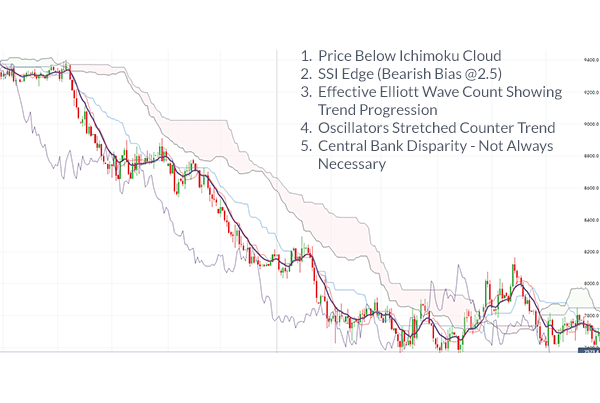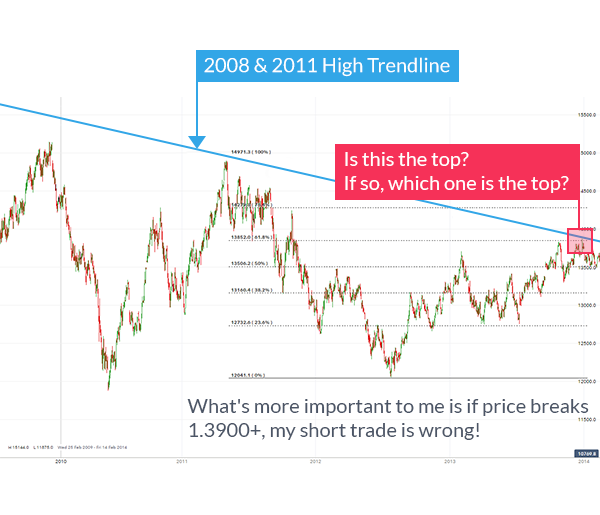
painofhell
-
Posts
5 -
Joined
-
Last visited
Content Type
Profiles
Forums
Articles
Posts posted by painofhell
-
-
Talking Points:
Where To Buy Is A Small Part Of the Puzzle
Learn How To Take Small Losses Early Is Key
Focus On Good Decisions More So Than Right / Wrong
“Accepting losses is the most important single investment devise to insure safety of capital”
It’s natural for you to look profitable FX traders to see what type of trading methodology you should take on. Because, you figure, if James Stanley is making money on the Finger Trap strategy, then that’s obviously the way to go right? But if he’s doing well with such a short-term methodology, why is Jeremy Wagner knocking out big moves with Elliott Wave & Donchian Channels? The answer to this question is that the truth about trading lies less is where to buy and more in deciding where you’re wrong and should get out of the trade.
Where to Buy Is a Small Part of the Puzzle
Of course, you should have an idea where is a good time to enter into a trade. I consider this an edge, when your entry has a better chance or probability of profit than a random entry. The most common of edges that you’ll hear us address at DailyFX is trading with the trend and when reasonable fading the crowd bias with our Sentiment Index. More importantly, it’s best to write down the key things that build your edge so that before you can objectify your edge and not be swayed by emotions before jumping in a trade.
Learn Forex: My Checklist for Entering a Trade

With my objective edge checklist displayed on the AUDUSD chart above it’s important that you understand that it doesn’t hold the path to riches but it is important. The importance lies in that you’re not being pulled by the latest news headline or largest candle on the chart which could just be a few large orders going through that doesn’t break the overall trend. In fact, a great investor of the 20th century, Sir John Templeton, used to keep a list of investments he’d make if a price got to a certain price and give it to an associate to enter orders so that he would not be dismayed by the news around that time and in effect keeping his buying objective when it was easier to be subjective.
The Bottom Line: You need to have an objective way of identifying the edge but getting into the trade isn’t nearly as important as getting out of the trade at appropriate points.
Learn How to Take Small Losses Early Is Key
If you decided to set out and learn the investing secrets of the top traders in the world, you’d likely end up more confused than when you started. The reason for the confusion is that you may read the great Paul Tudor Jones, who stated, “I believe the very best money is made at the market turns. Everyone says you get killed trying to pick tops and bottoms and you make all your money by playing the trend in the middle. Well for twelve years I have been missing the meat in the middle but I have made a lot of money at tops and bottoms."That could easily get you excited about learning how to read market turns but just as quickly, you may read Bernard Baruch stating, “Don't try to buy at the bottom and sell at the top. It can't be done except by liars.” or “I made my money by selling too soon,” which was in context of catching the meat of a move.
Learn Forex: Decide Where Your Trade Is Wrong before Deciding Where You’re Right

You’ll notice in the chart above that I don’t know if EURUSD will go to 1.3200, 1.2400, or lower but I know if EURUSD breaks above 1.3900 which is the trendline resistance that I do not belong in a short trade. Deciding and honoring your exit point is a very tough but critical point in trading and why two traders can be very successful but have completely different ways of entering into a trade. In other words, if one guy is doing great picking tops and bottoms and another is doing great catching the meat of the move then the common denominator of these professional traders is their ability to decide when they are wrong on the trade as per their analysis for getting in in the first place.
The Bottom Line: There are many roads that lead to trading well but there is only one highway to trading poorly and that is letting the market trade past your conviction point for getting into a trade. Make sure you know at what price you should no longer have your capital at risk or else you’re just gambling.
Focus on Good Decisions More Than If You’re Right / Wrong
It’s easy to close a profitable trade and think that you were right on your call or close out a losing trade and say you were wrong on the trade but that can be a harmful way of thinking. The harm comes from the fact that when you entered the trade, you may have an objective edge as we discussed earlier but you obviously didn’t know whether you’re trade would close at a profit or loss (or else, you’d never enter a losing trade again). What’s a more appropriate way to look at any trade is making sure that it’s based on good and methodical decisions because a decision is based on collecting the present data and putting the best foot (buy, sell, flat) forward, which is a fair definition of trading.
As you can imagine, in all of life, we’re always making decisions. When you’ve made a bad decision, in trading as in most of life, you’re best served in recognizing when the decision did not turn out as you hoped and changing your course of action as soon as possible. What can be harmful, is when you tied every decision you make to your ego so that you wait for the circumstances to hopefully turn so that you’re hopefully proven right and your ego is protected. This hope has cost many traders their career and I hope this article prevents anyone from repeating this mental error in 2014.
Closing Thoughts
Adjust your thinking on trading so that you see loss control and objective decision making that protects your capital as the cornerstone of your trading while see an entry price in less esteem as you may have earlier in your career. That is the truth of trading.
www.instaforex.com
-
1. Wrong Broker : A lot of forex brokers are horrible; get a good one. Read forums and chats in several different places to get an unbiased opinion.
2. Trading During Off Hours Bank FX traders, option traders, and hedge funds have a huge advantage during off hours; they can push the currencies around when no volume is going through and the end game is new traders get fleeced trying to trade signals. There is only one signal during off hours it is better to stay out.
3. Trading Against Prevailing Trend There is a huge difference between buying cheaply on the way down and buying cheaply. What was a low price quickly becomes a high price when you 're trading against the trend.
4. Picking Tops and Bottoms - Looking for bargains works well at the supermarket but not trading foreign exchange; try to trade in the direction the price is going and your results will improve.
5. Not Trading Around s Time : Most of the big moves occur around news time. The volume is high and the moves are real; there is no better time to trade fundamentally or technically than when news is released; this is when the real money adjusts their positions and as a result the prices changes reflect serious currency flow (compared to quiet times when bank traders rule the market with their customer order flow).
6. Ignore Technical Conditions : Determining whether the market is over-extended long or over-extended short is a key determinant of near-time price action. Spike moves often occur when the market is all one way.
7. Lack of Confidence Confidence only comes from successful trading. If you lose money early in your trading career it's very difficult to gain true confidence; the trick is don't go off half-cocked; learn the business before you trade.
8. Being Too Smart : The most successful traders I know are high school ****uates. They keep it simple and dont look beyond the obvious; their results are excellent.
9. Stop Losses : Putting tight stop losses with retail brokers is a recipe for disaster. When you put on a trade, commit to a reasonable stop loss limit that allows your trade a fair chance to develop.
10. Relying on Others : Real traders play a lone hand; they make their own decisions and dont rely on others to make their trading decisions for them; there is no halfway; either trade for yourself or have someone else trade for you.
11. Too Many Charity Trades : When you make money on a well thought-out trade, dont give back half on a whim; invest your profits from good trades on the next good trade
12. Too Much Detail : If you are trading more than 2 indicators, then you need to clean house. Having many indicators stifles trading and finds reasons not to trade. A setup and a trigger is all you need.
13.Overconfidence : Trading is not easy; statistics show a 95% failure rate. If your doing well dont take your success for granted; always be on the lookout for ways to improve what you 're doing.
14. Knowledge Deficiency: Most new forex traders do not take the time to learn what drives currency rates (primarily fundamentals). When some news or a statement is due out, they close out their positions and sit out the best trading opportunities; they are taught to only trade after the market calms down. So essentially they miss the whole move and then trade the random noise that follows a fundamental price move. Just think for a moment about technically trading the aftermath of a price move; there is no potential.
15. Rumors : Rumors are rumors almost 100% of the time; think about where in the motion you heard the rumor. If EUR/USD is up 50 points in last 15 minutes and the rumor is dollar negative, well then you missed it. Whenever you trade, determine where in the motion you are entering.
Hope its will help all of you..







How to Trade Panic
in General Forex Discussions
Posted
If you lived in the United States before the year 2000, the thought of yellow and orange-jacketed traders screaming at the top of their lungs across a rainbow of other-colored jackets, slips of paper flying everywhere, is probably something you associate with markets and exchanges. These stressful environments were synonymous with the notion of markets. Emotions ran high, and depending on the exchange – one may even be risking their own personal safety by entering ‘the floor.’
Times have changed quite a bit; many exchanges exist only in cyberspace, no longer seeing the need for physical manifestations of their trading activity. Even the New York Stock Exchange; have you seen it lately? If not, just turn on CNBC, it's not like it used to be (quite a bit more quiet these days).
But one thing that hasn’t changed is the fact that people love fast markets. Only now they mostly exist through the Internet, and now they are available to anyone willing to risk their money – not only the select few that could afford or draw on family connections for a ‘seat on the floor.’
When a big news event happens; or even perhaps a news event driven by an economic catalyst, like the 2008 Financial Collapse, markets can attempt to price in the newest data so fast that prices move at breakneck speeds. For the poor investors that are in long positions in mutual funds, the hope of stemming the bleeding before market close doesn't exist. They have to wait and watch the devastation until the end of the trading day so that they redeem out of their mutual funds.
But to the trader that can take a short position just as quickly as ‘hitting the bid,’ these ‘panic’ periods present quite a bit of opportunity. Prices are moving fast and pips can stack up quickly – if you are on the right side of the trade. The big question is if this is something that fits in your trading plan?
What type of trader are you?
By many accounts – fundamentals and news events create price changes, thereby – fundamentals dictate what prices will do. Technical analysis on the other hand, analyzes past price movements, showing us what prices have done. And sometimes, what price has done in the past can help us build a game plan for the future; looking to those fundamental catalysts to create big price movements (the hybrid fundamental-technical trader).
The alternative approach is the trader that analyzes those same past events, looking to avoid those fundamental catalysts, hoping that the technical levels from the past hold true (the technical-range trader).
That’s really all there is. A pure fundamentals trader wouldn’t be looking at charts at all, and a ‘technical-breakout/trend’ trader would really be, in many ways, looking to fundamentals to continue substantiation of those trending/breakout conditions, so they wouldn’t really be a ‘pure technical’ trader.
Considering the fact that ‘panic’ markets can create rapid price movements in a short period of time, which can just as easily work against the trader as it can for them, it behooves one to know as much about their risk profile before wagering their hard-earned capital.
So, if you consider yourself a ‘pure technical’ trader, and have no interest whatsoever in following or keeping up with the news – I advise you to attempt to avoid panic markets. This can often be done by setting stops at major levels of support (or resistance in the case of short positions) so that when we do get those big breakouts – they don’t work against you too heavily.
For all those that dare to tread in fast markets – read on; and we will share with you some ways that experienced traders approach these volatile scenarios.
How to Trade Fast Markets
The same question was broached in the article ‘How to Trade Forex Majors Like the Euro during Active Hours,’ and the recommendation to trade breakout strategies could not be more on point.
As David shows in the article, increased activity often means larger and potentially more erratic price movements. And because these movements can be more erratic, it can greatly affect the trader’s ability to forecast price changes. The chart below, taken from the aforementioned article, shows how widely price swings can magnify on EURUSD during the London and the London/US overlap session (often considered the most ‘active’ period in the FX market).
Now if we consider that panic markets often have an external stimuli; whether it be a natural disaster like what was seen in Japan in 2011, or a man-made disaster like what was seen at Bear Sterns and Lehman Brothers in 2008 – we have to know the market movements can be even more exaggerated, meaning price movements can become even more magnified, and forecasting can become even more difficult.
Why trade breakouts to address panic?
Because price movements can become greatly magnified while also becoming more erratic is the reason why trading breakouts is the best prescription for handling volatility. If we happen to be on the right side of the movement, price can trend for a continued period of time, giving us far greater potential profit targets if we are right. If we’re on the wrong side of the movement (which will probably happen more than half of the time), then we can cut our losses early before the pair continues against us in a move that could potentially drain our accounts.
A critical aspect of trading breakouts is the necessity of strong risk-reward ratios, such as the trader risking 20 pips, but looking for 100 pips if correct. This could be expressed as a 1-to-5 risk-to-reward ratio (20 pips to the stop-loss order – 100 pips to the profit target = 1:5 risk-to-reward).
This is what can allow rampant volatility to actually work in your favor.
With a risk-reward ratio so aggressively on the trader’s side, one would need to be right only 2 out of 5 times to gleam a net profit. If a trader was right 40% of the time with a 1-to-5 risk-to-reward ratio, they could be looking at a handsome profit (2 winning trades at 100 pips each = 200 pips won, 3 losing trades at 20 pips each = 60 pips lost, net profit of 140 pips (200-60) not including commissions, slippage, etc).
But what if the trader above was only right on one out of five trades? Well, they are still looking at a net profit (once again, not including spreads, slippage, etc). One winning trade at 100 pips only gives up 80 to 4 losers at 20 pips each, leaving a net profit of 20 pips; and that is with a winning ratio of 20%.
How to Trade Breakouts
An easy way of looking at breakout strategies is to simply think of ranges – and then reverse it.
While range-traders look to buy support and sell resistance, breakout traders await breaks of resistance to buy (in anticipation of price continuing to rise now that resistance is broken) and looking to sell when support is breached (once again, looking for price to continue heading lower).
There are numerous ways of identifying support and resistance levels to be used for breakout strategies. Some traders don’t even use indicators, electing, instead, to simply analyze and build their strategies off of price, and price action. Some traders rather use strategies based on indicators like Price Channels to point out these support and resistance levels. Many of the various Pivot Point offerings or Fibonacci studies can help in this same regard as well.
Whatever the mechanism, it is important to realize that complete elimination of false breakouts is totally impossible. What often makes or breaks a breakout strategy is money, risk, and trade management.
This is a hazard sport, as it can be a regular occurrence for price to break support (or resistance) briefly enough to trigger our, only to pop back into its prior range. This can be frustrating for breakout traders, and has even earned the title of the ‘false breakout.’
This topic was explored in greater detail by Walker England in the article ‘Can False Breakouts be Prevented?’
Not to spoil the article, which you should absolutely read, but the answer to the question is ‘No.’ False breakouts, unfortunately, cannot be prevented.
To the trader looking to be more conservative, additional ‘wiggle room’ can be given to the entry in an effort to attempt to decrease the chances of caught by a false breakout.
But preventing false breakouts is impossible due to the simple fact that no trader in the world knows what will happen next. So when trading panic markets, protect your trade, protect your account, and trade your plan.
www.instaforex.com